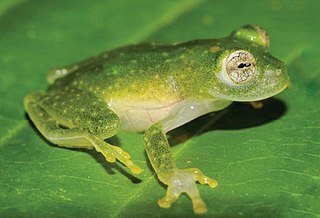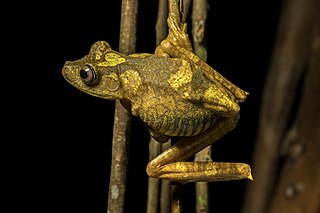
Stefania is a genus of frogs in the family Hemiphractidae. They are native to the highlands of the Guiana Shield in southern Venezuela, Guyana, and adjacent far northern Brazil. Most are restricted to the tepui highlands, but S. evansi also occurs in lowlands. On most mountains there are only 1–2 species from this genus, but five are known from Mount Ayanganna and the neighbouring Mount Wokomung has six species. They are usually found near streams at low levels on branches/leaves or on the ground among vegetation/rocks.

Hyalinobatrachium taylori is a species of frog in the family Centrolenidae. Its common name is Taylor's glass frog, and in Spanish, ranita de cristal de Taylor. It may represent at least two distinct species.
Warren's tree frog is a species of frog in the family Hylidae found in Guyana and possibly Brazil and Venezuela. Its natural habitats are subtropical or tropical moist montane forests, rivers, freshwater marshes, and intermittent freshwater marshes.

The map tree frog is a species of frog in the family Hylidae found in Bolivia, Brazil, Colombia, Ecuador, French Guiana, Guyana, Peru, Suriname, Trinidad and Tobago, and Venezuela. Its natural habitats are subtropical or tropical dry forests, subtropical or tropical moist lowland forests, moist savanna, subtropical or tropical seasonally wet or flooded lowland grassland, rivers, freshwater lakes, intermittent freshwater lakes, freshwater marshes, plantations, rural gardens, heavily degraded former forests, ponds, and aquaculture ponds. It was previously known as Hyla geographica. The name comes from the reticulated map-like patterns on its eyelids (palpebrum). The black tadpoles congregate in dense clusters in ponds or other calm waters.
The Lema tree frog is a species of frog in the family Hylidae found in Guyana, Venezuela, and possibly Brazil. Its natural habitats are subtropical or tropical moist lowland forests, subtropical or tropical moist montane forests, rivers, pastureland, rural gardens, heavily degraded former forests, aquaculture ponds, and canals and ditches. It is threatened by habitat loss.
Hoogmoed's tree frog is a species of frog in the family Hylidae found in Guyana, possibly Brazil, and possibly Venezuela. Its natural habitats are subtropical or tropical moist montane forests and rivers.
The La Escalera tree frog is a species of frog in the family Hylidae found in Guyana, Venezuela, and possibly Brazil. Its natural habitats are subtropical or tropical moist lowland forests, subtropical or tropical moist montane forests, rivers, and freshwater marshes.
Nesorohyla is a monotypic genus of frogs in the family Hylidae. The sole species is Nesorohyla kanaima, also known as the Kanaima treefrog. It is endemic to Guyana. and possibly Brazil and Venezuela. Its natural habitats are subtropical or tropical moist lowland forests, subtropical or tropical moist montane forests, and rivers.
Stefania ackawaio is a species of frog in the family Hemiphractidae. It is endemic to Guyana. Its natural habitat is subtropical or tropical moist montane forests.
Stefania ayangannae is a species of frog in the family Hemiphractidae. It is endemic to Guyana where it is known from Mount Ayanganna and Mount Wokomung, both in the Pacaraima Mountains.
Stefania coxi is a species of frog in the family Hemiphractidae. It is endemic to Guyana and has been found on Mount Ayanganna and Mount Wokomung. Its natural habitat is subtropical or tropical moist montane forests at higher elevations.

Stefania evansi is a species of frog in the family Hemiphractidae. Stefania evansi is, along with other closely related frogs, known for its unusual reproductive mode where females carry the eggs and juveniles on their back. It is sometimes known under common names Groete Creek carrying frog, Groete Creek treefrog, or Evans' stefania. These names refer to its type locality, Groete Creek in the region Essequibo Islands-West Demerara, Guyana, where the holotype was collected by one Dr. R. Evans.
Stefania roraimae is a species of frog in the family Hemiphractidae. It is endemic to Guyana. Its type locality is Mount Roraima; it is also known from Mount Ayanganna and Mount Wokomung. It presumably occurs in the adjacent Venezuela and Brazil too.
Stefania woodleyi is a species of frog in the family Hemiphractidae. It is endemic to the eastern part of the Pakaraima Mountains in Guyana, including Mount Wokomung and Mount Ayanganna.

Otophryne pyburni is a species of frog in the family Microhylidae. It is found in northern South America east of the Andes. It is a common, diurnal frog found in tropical rainforest, perching next to streams or living on the forest floor under leaves or among roots. Males are territorial and calling mostly on rainy days. The eggs may be laid either inside or outside water. The tadpoles are aquatic and hide under leaves in small ponds. It is locally threatened by habitat loss.
Otophryne steyermarki is a species of frog in the family Microhylidae. It is found in western Guyana and in the Bolívar state in eastern Venezuela.
The Arrabal's Suriname toad is a species of frog in the family Pipidae found in Brazil, Guyana, Suriname, Venezuela, and possibly Peru. Its natural habitats are subtropical or tropical moist lowland forests, freshwater marshes, intermittent freshwater marshes, ponds, and canals and ditches. It is threatened by habitat loss.
Rhinatrema nigrum, the black caecilian, is a species of caecilian in the family Rhinatrematidae found in Guyana, Venezuela, and possibly Brazil. Its natural habitats are subtropical or tropical moist lowland forests, subtropical or tropical moist montane forests, rivers, and intermittent rivers.
Dipsas pakaraima is an arboreal snake of the family Dipsadidae. It has been placed in the Dipsas temporalis group. It is native to medium and higher elevations in west-central Guyana. It has been collected in Kaieteur National Park and Mount Ayanganna. Its food probably consists of snails and slugs.
Yanomamia guianensis is a South American lizard of the family Gymnophthalmidae. It has been found only at higher elevations on Mount Ayanganna and Mount Roraima in west-central Guyana.




